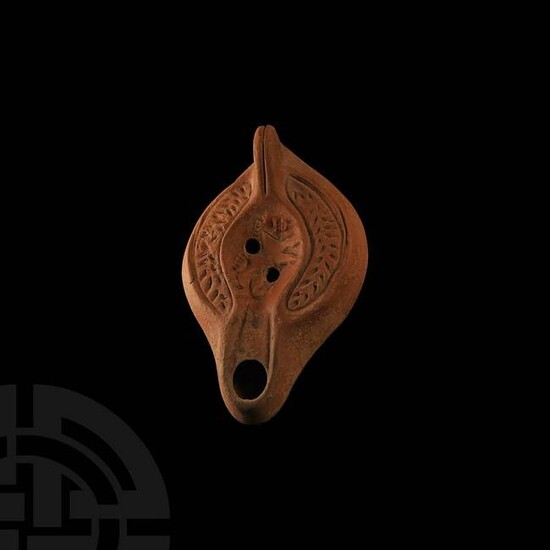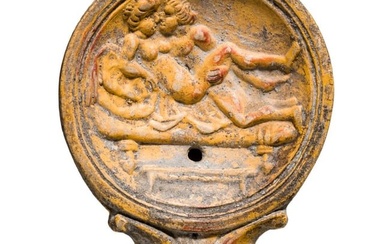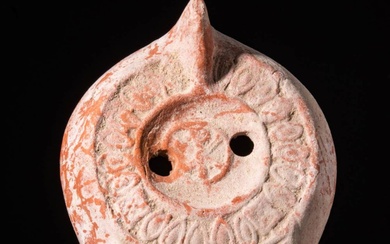Roman Oil Lamp with Running Horse
4th-5th century AD. A plaster mould-made terracotta lamp, solid handle with median groove running from front to back, roughly oval-shaped body, convex shoulder with imitation of palm foliage separated from the discus by a strong ridge leaving a long broad channel between them; two filling-holes of equal size right and left of discus image, decorated with a horse running to right; raised basal ring. See similar specimen in Bailey, D.M., A Catalogue of the Lamps in the British Museum III, London, 1988, no.Q1747, pl.19. 169 grams, 13.5cm (5 1/2"). Property of an Essex gentleman; acquired on the UK art market; previously in a German collection collection formed since 1970. The Hayes type I lamp, to which this specimen belongs, began probably to be made in the last quarter of the 4th century and continued to the end of the 5th century AD according to Bailey. Pavolini proposes a different temporal range, between 325-550 AD, based on the material excavated by the Italians in Carthage. What is sure is that, beginning from the 4th century, the African workshops of the Roman Empire which had, from Flavian times onwards, been producing tableware in African red slip ware started to make lamps and were used in all parts of the Empire until the 6th century AD.
Condition Report: Fine condition.
View it on
Estimate
Time, Location
Auction House
4th-5th century AD. A plaster mould-made terracotta lamp, solid handle with median groove running from front to back, roughly oval-shaped body, convex shoulder with imitation of palm foliage separated from the discus by a strong ridge leaving a long broad channel between them; two filling-holes of equal size right and left of discus image, decorated with a horse running to right; raised basal ring. See similar specimen in Bailey, D.M., A Catalogue of the Lamps in the British Museum III, London, 1988, no.Q1747, pl.19. 169 grams, 13.5cm (5 1/2"). Property of an Essex gentleman; acquired on the UK art market; previously in a German collection collection formed since 1970. The Hayes type I lamp, to which this specimen belongs, began probably to be made in the last quarter of the 4th century and continued to the end of the 5th century AD according to Bailey. Pavolini proposes a different temporal range, between 325-550 AD, based on the material excavated by the Italians in Carthage. What is sure is that, beginning from the 4th century, the African workshops of the Roman Empire which had, from Flavian times onwards, been producing tableware in African red slip ware started to make lamps and were used in all parts of the Empire until the 6th century AD.
Condition Report: Fine condition.







